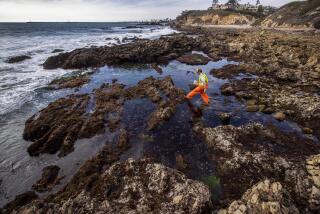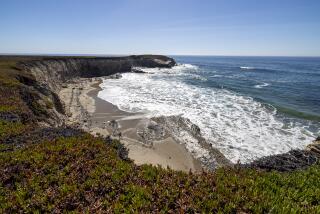Study Set on Ban of Oil Tankers in Channel : Santa Barbara: A ‘tanker-free zone’ designation would force oil-carrying vessels to steer clear of the Channel Islands.
- Share via
President Bush has directed the Coast Guard to study the creation of a “tanker-free zone” in the Santa Barbara Channel that would divert oil-laden supertankers outside the Channel Islands.
In signing oil cleanup legislation Saturday, Bush authorized a congressional request to study the advisability of declaring the Santa Barbara Channel a “tanker-free zone” and whether such a designation “would be consistent with offshore oil and gas development.”
The study was immediately applauded by environmentalists as a positive step toward protecting the coastline. But oil industry representatives expressed concern over whether such restrictions would prevent tankers from reaching oil terminals in Ventura and Santa Barbara counties.
In February, six major oil companies agreed to steer their tankers loaded with Alaska crude oil around the Channel Islands on their way to Southern California ports.
Yet, some foreign tankers continue to use the channel, which extends beyond the United States’ 12-mile territorial zone into international waters with guaranteed navigation rights.
Rep. Robert J. Lagomarsino (R-Ventura) has tried unsuccessfully to get a bill passed that would ban all tanker traffic in the channel and thus reduce the threat of a major spill, such as those off Alaska and Huntington Beach.
But his efforts have been rebuffed because such a law could only apply to U.S. tankers and would allow only foreign vessels to take the shorter route.
“If the study shows it’s advisable, we could declare the channel off-limits to all tankers, including foreign vessels,” Lagomarsino said in a statement.
“Canada, for instance, has established ‘tanker-free zones’ to minimize the exposure of its sensitive shoreline areas to potential contamination from discharges of oil or hazardous substances,” said the congressional report accompanying the bill Bush signed into law.
The new law, spurred through Congress by the 11-million-gallon spill by the Exxon Valdez in Alaska, requires double-hull construction of tankers and sets up a $1-billion fund to cover cleanup costs and damages not paid by the polluter.
One section of the law calls for the Coast Guard to study limits on tankers in the Santa Barbara Channel and a channel between Montauk Point, N.Y., and Block Island, R.I. The narrow channel off New York has been the site of numerous accidents.
The Channel Islands and Ventura and Santa Barbara county coastlines are considered environmentally fragile areas that have become a battleground between environmentalists and oil companies tapping offshore oil reserves.
“Any protection of the coastline is a positive step,” said Pat Baggerly of the Ventura County Environmental Coalition. “We just wish it was more complete.”
But oil industry representatives expressed reservations about preventing oil tankers from reaching a power plant at Mandalay Bay fueled by oil from the tankers or another terminal scheduled to be opened north of Santa Barbara.
“Our first concern is whether the limits would affect existing or planned terminals,” said Terry Covington, director of the California Coastal Operators Group, an oil industry consortium. “The study isn’t necessarily bad, but the tanker-free zone raises a lot of red flags.”
Chevron Spokesman G.M. (Mike) Marcy said his company has voluntarily routed its tankers from Alaska outside the Channel Islands. But, he said, Chevron tankers will need to enter the channel to collect oil from its interim terminal at Gaviota, north of the islands, until a pipeline can be approved and built.
“We at Chevron recognized that piping is a preferable way to transport oil,” Marcy said. However, he said the company’s efforts have been blocked by political opposition. “Nobody wants a pipeline running through their back yard.”
Initially, the routing of tankers outside the Channel Islands raised concerns at the Pacific Missile Test Center at Point Mugu, which fires missiles at targets in a huge test range outside the channel.
Lt. Cmdr. Gene Okamoto said Navy officials have been able to avoid conflicts by keeping in close contact with oil tankers and coordinating their movement through the area.
“It seems to be working so far,” Okamoto said. “Adding a few more tankers shouldn’t be much of a problem.”
More to Read
Sign up for Essential California
The most important California stories and recommendations in your inbox every morning.
You may occasionally receive promotional content from the Los Angeles Times.










